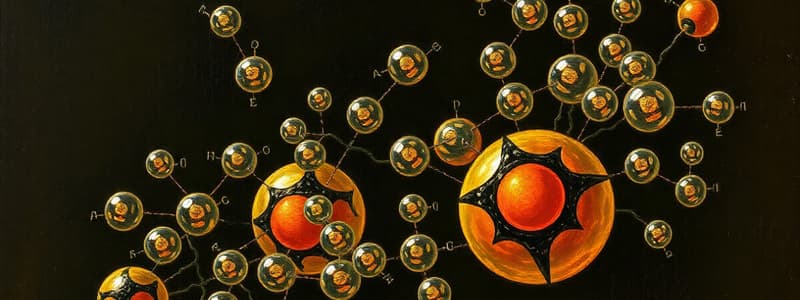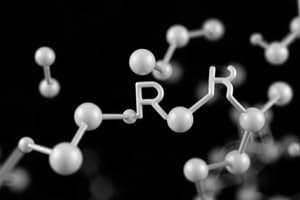Podcast
Questions and Answers
Which type of amino acid R-group is characterized by being non-polar and hydrophobic?
Which type of amino acid R-group is characterized by being non-polar and hydrophobic?
- Polar-neutral R groups
- Polar acidic R groups
- Non-polar, aliphatic R groups (correct)
- Polar basic R groups
Which classification does an amino acid with a carboxyl group in its side chain belong to?
Which classification does an amino acid with a carboxyl group in its side chain belong to?
- Polar acidic R groups (correct)
- Polar neutral R groups
- Polar basic R groups
- Non-polar, aromatic R groups
What characterizes polar-neutral amino acids?
What characterizes polar-neutral amino acids?
- They contain a carboxyl group in their side chain
- They are insoluble in water
- They contain polar but neutral side chains (correct)
- They have hydrophobic R groups
Which of the following amino acid classifications is characterized by aromatic side chains?
Which of the following amino acid classifications is characterized by aromatic side chains?
Which of the following statements about the shorthand notations for amino acids is true?
Which of the following statements about the shorthand notations for amino acids is true?
What characterizes a zwitterion?
What characterizes a zwitterion?
At which pH is an amino acid likely to be a zwitterion?
At which pH is an amino acid likely to be a zwitterion?
What occurs to amino acids in solution at high pH?
What occurs to amino acids in solution at high pH?
What is the isoelectric point (pI) of an amino acid?
What is the isoelectric point (pI) of an amino acid?
Which statement best describes amino acids in relation to pH changes?
Which statement best describes amino acids in relation to pH changes?
Flashcards
Amino Acid Classification
Amino Acid Classification
Amino acids are classified based on their R-groups, which determine their polarity and interaction with water.
Non-polar Amino Acids
Non-polar Amino Acids
Non-polar amino acids have R-groups that are neutral, hydrophobic, and dislike water. They tend to hide inside proteins.
Polar Amino Acids
Polar Amino Acids
Polar amino acids are hydrophilic, meaning they love water and are attracted to it. They are further divided into three subtypes.
Polar-neutral Amino Acids
Polar-neutral Amino Acids
Signup and view all the flashcards
Polar acidic Amino Acids
Polar acidic Amino Acids
Signup and view all the flashcards
Polar basic Amino Acids
Polar basic Amino Acids
Signup and view all the flashcards
Amino Acid Forms
Amino Acid Forms
Signup and view all the flashcards
Isoelectric Point (pI)
Isoelectric Point (pI)
Signup and view all the flashcards
Peptide Bond Formation
Peptide Bond Formation
Signup and view all the flashcards
Peptide Nomenclature
Peptide Nomenclature
Signup and view all the flashcards
Study Notes
Amino Acids Classification
- Amino acids are classified into five groups based on R-groups, according to their polarity and interaction with water.
- Non-polar, aliphatic R groups are neutral, hydrophobic, and found in the protein's interior.
- Non-polar, aromatic R groups are also neutral, non-polar, and engage in hydrophobic interactions.
- Polar amino acids are hydrophilic and are divided into:
- Polar-neutral: more soluble in water.
- Polar acidic: contain carboxyl groups.
- Polar basic: contain amino groups.
Nomenclature and Forms
- Amino acids have common names and shorthand notations; three-letter and one-letter abbreviations are widely used.
- The first letter of the amino acid name is capitalized; for certain amino acids, the first three letters may include only the first letter capitalized.
- α-amino acids are typically written in zwitterion form, representing their internal salt structure.
Acid-Base Properties
- Amino acids exist as zwitterions—molecules with both positive and negative charges and a net zero charge.
- Carboxyl groups release protons (H+) while amino groups accept protons to create positive charges.
- The net charge of an amino acid in solution varies with pH, shifting between zwitterions, positive ions, and negative ions.
Isoelectric Point (pI)
- The isoelectric point is the specific pH where an amino acid has a net charge of zero.
- Amino acids are not attracted to electric fields at their pI.
- Different amino acids have unique isoelectric points depending on their structure and side chains.
Guidelines for Amino Acid Forms
- At low pH: all carboxyl and amino groups are protonated (net + charge).
- At high pH: all groups are deprotonated (net - charge).
- At neutral pH: carboxyl groups are deprotonated; amino groups are protonated (net 0 charge).
pKa Values and Peptide Behavior
- Different amino acids have varying pKa values that affect their ionization and charge at specified pH levels.
- Proteins and peptides act as zwitterions and have isoelectric points; their solubility changes with pH, affecting precipitation.
Formation of Peptides
- Emil Fischer proposed that proteins are chains of amino acids connected by peptide bonds (amide bonds).
- The peptide bond forms between the α-carboxyl group of one amino acid and the α-amino group of another.
Writing Peptides
- Peptides are depicted from left to right, starting with the N-terminal (free -NH3+) to the C-terminal (free -COO-).
- N-terminal and C-terminal designations indicate positions in the amino acid sequence.
Peptide Nomenclature
- The IUPAC naming convention replaces amino acid name endings with the suffix "-yl," except for the C-terminal amino acid, which retains its full name.
- Example notation for a peptide includes the sequence: Ala-Phe-Ser; abbreviation: AFS.
Studying That Suits You
Use AI to generate personalized quizzes and flashcards to suit your learning preferences.




